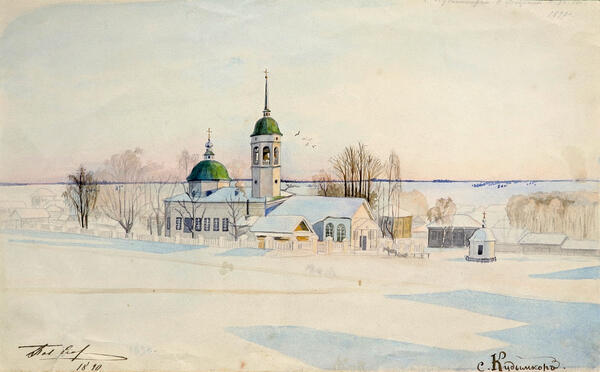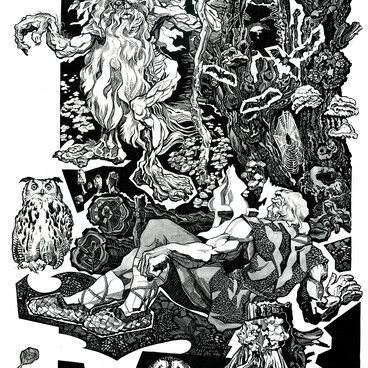The watercolor winter landscape features the most important place of the village of Kudymkar, the center of the Invensky okrug of the Stroganovs’ estate in Perm — Saint Nicholas Church. The white-stone building with a high bell tower and green domes rises amidst snow-covered fields. Around the church there are bare trees and an unassuming fence, a horse and a sled, and a round stone chapel. In the distance on the horizon there are some wooden dwellings.
The earliest written record of the village Kudymkar dates back to 1579. Its name is translated from the Komi-Permyak language as “the town near the river Kuva”, and the word “Kuva” means “dead water”. At the beginning of the 18th century Kudymkar became the center of the Perm land holdings belonging to the Counts of Stroganov. The village was intensively developed, streets were laid out. Stone houses, a college, workshops, a bathhouse, and a bridge over the Inva River were built.
In the central, historical part of Kudymkar, a stone church of Saint Nicholas the Wonderworker was built, later to become the main orthodox church of the southern Komi-Permyaks. The letter of permission for its construction was issued by Bishop Lavrentiy of Vyatka and Great Perm in 1795. The construction of the temple was funded by Count Alexander Stroganov and took about four years.
According to local historians, the church was built by the architect Andrey Voronikhin, who came from a family of serfs belonging to Count Stroganov. Saint Nicholas Church was built in the style of Russian classicism, it was built in the form of a “ship” and consists of an elongated pentagonal apse, the temple part, the refectory and the bell tower. The bell tower, the temple and the altar part are crowned with domes.
Sixty-five years after the church was built, a wooden corridor with four lateral chambers — an extension to the western facade of the church —was built at the parishioners’ expense. The square near Saint Nicholas Church used to be called Bazarnaya Square, and it was the venue of all city events, fairs and festivities. In 1892, the geographer and historian of Perm Governorate Ivan Krivoshchekov had a park laid around the church. The park was later renamed in his honor and renovated in 2018.
The earliest written record of the village Kudymkar dates back to 1579. Its name is translated from the Komi-Permyak language as “the town near the river Kuva”, and the word “Kuva” means “dead water”. At the beginning of the 18th century Kudymkar became the center of the Perm land holdings belonging to the Counts of Stroganov. The village was intensively developed, streets were laid out. Stone houses, a college, workshops, a bathhouse, and a bridge over the Inva River were built.
In the central, historical part of Kudymkar, a stone church of Saint Nicholas the Wonderworker was built, later to become the main orthodox church of the southern Komi-Permyaks. The letter of permission for its construction was issued by Bishop Lavrentiy of Vyatka and Great Perm in 1795. The construction of the temple was funded by Count Alexander Stroganov and took about four years.
According to local historians, the church was built by the architect Andrey Voronikhin, who came from a family of serfs belonging to Count Stroganov. Saint Nicholas Church was built in the style of Russian classicism, it was built in the form of a “ship” and consists of an elongated pentagonal apse, the temple part, the refectory and the bell tower. The bell tower, the temple and the altar part are crowned with domes.
Sixty-five years after the church was built, a wooden corridor with four lateral chambers — an extension to the western facade of the church —was built at the parishioners’ expense. The square near Saint Nicholas Church used to be called Bazarnaya Square, and it was the venue of all city events, fairs and festivities. In 1892, the geographer and historian of Perm Governorate Ivan Krivoshchekov had a park laid around the church. The park was later renamed in his honor and renovated in 2018.



